Generation and Characterization of Mid-Infrared Supercontinuum in Bulk YAG Pumped by Femtosecond 1937 nm Pulses from a Regenerative Amplifier
Abstract
:1. Introduction
2. Experimental Setup
3. Results and Discussion
4. Conclusions
Author Contributions
Funding
Conflicts of Interest
References
- Kassamakov, I.; Hanhijärvi, K.; Abbadi, I.; Aaltonen, J.; Ludvigsen, H.; Hæggström, E. Scanning white-light interferometry with a supercontinuum source. Opt. Lett. 2009, 34, 1582–1584. [Google Scholar] [CrossRef] [PubMed]
- Nishizawa, N.; Kawagoe, H.; Yamanaka, M.; Matsushima, M.; Mori, K.; Kawabe, T. Wavelength Dependence of Ultrahigh-Resolution Optical Coherence Tomography Using Supercontinuum for Biomedical Imaging. IEEE J. Sel. Top. Quantum Electron. 2019, 25, 1–15. [Google Scholar] [CrossRef]
- Schliesser, A.; Picqué, N.; Hänsch, T.W. Mid-infrared frequency combs. Nat. Photonics 2012, 6, 440–449. [Google Scholar] [CrossRef] [Green Version]
- Coddington, I.; Newbury, N.; Swann, W. Dual-comb spectroscopy. Optica 2016, 3, 414–426. [Google Scholar] [CrossRef] [Green Version]
- Rezvani, S.A.; Zhang, Q.; Hong, Z.; Lu, P. Tunable broadband intense IR pulse generation at non-degenerate wavelengths using group delay compensation in a dual-crystal OPA scheme. Opt. Express 2016, 24, 11187–11198. [Google Scholar] [CrossRef] [PubMed]
- Zhang, Q.; Takahashi, E.J.; Mücke, O.D.; Lu, P.; Midorikawa, K. Dual-chirped optical parametric amplification for generating few hundred mJ infrared pulses. Opt. Express 2011, 19, 7190–7212. [Google Scholar] [CrossRef] [PubMed]
- Mundry, J.; Lohrenz, J.; Betz, M. Tunable femtosecond near-IR source by pumping an OPA directly with a 90 MHz Yb:fiber source. Appl. Opt. 2017, 56, 3104–3108. [Google Scholar] [CrossRef] [PubMed]
- Andersen, T.V.; Schmidt, O.; Bruchmann, C.; Limpert, J.; Aguergaray, C.; Cormier, E.; Tünnermann, A. High repetition rate tunable femtosecond pulses and broadband amplification from fiber laser pumped parametric amplifier. Opt. Express 2006, 14, 4765–4773. [Google Scholar] [CrossRef] [PubMed] [Green Version]
- Liang, H.; Krogen, P.; Wang, Z.; Park, H.; Kroh, T.; Zawilski, K.; Schunemann, P.; Moses, J.; DiMauro, L.F.; Kärtner, F.X.; et al. High-energy mid-infrared sub-cycle pulse synthesis from a parametric amplifier. Nat. Commun. 2017, 8, 141. [Google Scholar] [CrossRef] [PubMed]
- Huang, S.W.; Cirmi, G.; Moses, J.; Hong, K.H.; Bhardwaj, S.; Birge, J.R.; Chen, L.J.; Li, E.; Eggleton, B.J.; Cerullo, G.; et al. High-energy pulse synthesis with sub-cycle waveform control for strong-field physics. Nat. Photonics 2011, 5, 475–479. [Google Scholar] [CrossRef]
- Yin, Y.; Li, J.; Ren, X.; Wang, Y.; Chew, A.; Chang, Z. High-energy two-cycle pulses at 3.2 μm by a broadband-pumped dual-chirped optical parametric amplification. Opt. Express 2016, 24, 24989–24998. [Google Scholar] [CrossRef] [PubMed]
- Ishii, N.; Xia, P.; Kanai, T.; Itatani, J. Optical parametric amplification of carrier-envelope phase-stabilized mid-infrared pulses generated by intra-pulse difference frequency generation. Opt. Express 2019, 27, 11447–11454. [Google Scholar] [CrossRef] [PubMed]
- Brida, D.; Cirmi, G.; Manzoni, C.; Bonora, S.; Villoresi, P.; Silvestri, S.D.; Cerullo, G. Sub-two-cycle light pulses at 1.6 μm from an optical parametric amplifier. Opt. Lett. 2008, 33, 741–743. [Google Scholar] [CrossRef] [PubMed]
- Hong, Z.; Zhang, Q.; Rezvani, S.A.; Lan, P.; Lu, P. Tunable few-cycle pulses from a dual-chirped optical parametric amplifier pumped by broadband laser. Opt. Laser Technol. 2018, 98, 169–177. [Google Scholar] [CrossRef]
- Calegari, F.; Sansone, G.; Stagira, S.; Vozzi, C.; Nisoli, M. Advances in attosecond science. J. Phys. B At. Mol. Opt. Phys. 2016, 49, 062001. [Google Scholar] [CrossRef]
- Chen, M.C.; Mancuso, C.; Hernández-García, C.; Dollar, F.; Galloway, B.; Popmintchev, D.; Huang, P.C.; Walker, B.; Plaja, L.; Jaroń-Becker, A.A.; et al. Generation of bright isolated attosecond soft X-ray pulses driven by multicycle midinfrared lasers. Proc. Natl. Acad. Sci. USA 2014, 111, E2361–E2367. [Google Scholar] [CrossRef] [PubMed] [Green Version]
- Takahashi, E.J.; Lan, P.; Mücke, O.D.; Nabekawa, Y.; Midorikawa, K. Infrared Two-Color Multicycle Laser Field Synthesis for Generating an Intense Attosecond Pulse. Phys. Rev. Lett. 2010, 104, 233901. [Google Scholar] [CrossRef] [PubMed]
- Silva, F.; Austin, D.R.; Thai, A.; Baudisch, M.; Hemmer, M.; Faccio, D.; Couairon, A.; Biegert, J. Multi-octave supercontinuum generation from mid-infrared filamentation in a bulk crystal. Nat. Commun. 2012, 3, 807. [Google Scholar] [CrossRef] [PubMed] [Green Version]
- Manzoni, C.; Cerullo, G. Design criteria for ultrafast optical parametric amplifiers. J. Opt. 2016, 18, 103501. [Google Scholar] [CrossRef] [Green Version]
- Shirakawa, A.; Sakane, I.; Takasaka, M.; Kobayashi, T. Sub-5-fs visible pulse generation by pulse-front-matched noncollinear optical parametric amplification. Appl. Phys. Lett. 1999, 74, 2268–2270. [Google Scholar] [CrossRef]
- Brida, D.; Manzoni, C.; Cirmi, G.; Marangoni, M.; Silvestri, S.D.; Cerullo, G. Generation of broadband mid-infrared pulses from an optical parametric amplifier. Opt. Express 2007, 15, 15035–15040. [Google Scholar] [CrossRef] [PubMed]
- Zavelani-Rossi, M.; Cerullo, G.; Silvestri, S.D.; Gallmann, L.; Matuschek, N.; Steinmeyer, G.; Keller, U.; Angelow, G.; Scheuer, V.; Tschudi, T. Pulse compression over a 170-THz bandwidth in the visible by use of only chirped mirrors. Opt. Lett. 2001, 26, 1155–1157. [Google Scholar] [CrossRef] [PubMed]
- Baltuška, A.; Fuji, T.; Kobayashi, T. Visible pulse compression to 4 fs by optical parametric amplification and programmable dispersion control. Opt. Lett. 2002, 27, 306–308. [Google Scholar] [CrossRef] [PubMed]
- Hong, Z.; Rezvani, S.A.; Zhang, Q.; Cao, W.; Lu, P. Ultrabroadband microjoule 1.8 μm laser pulse from a single-stage broadband pumped OPA. Opt. Lett. 2018, 43, 3706–3709. [Google Scholar] [CrossRef] [PubMed]
- Qin, G.; Yan, X.; Kito, C.; Liao, M.; Chaudhari, C.; Suzuki, T.; Ohishi, Y. Ultrabroadband supercontinuum generation from ultraviolet to 6.28 μm in a fluoride fiber. Appl. Phys. Lett. 2009, 95, 161103. [Google Scholar] [CrossRef]
- Rezvani, S.A.; Nomura, Y.; Ogawa, K.; Fuji, T. Generation and characterization of mid-infrared supercontinuum in polarization maintained ZBLAN fibers. Opt. Express 2019, 27. in press. [Google Scholar] [CrossRef]
- Gaeta, A.L. Catastrophic Collapse of Ultrashort Pulses. Phys. Rev. Lett. 2000, 84, 3582–3585. [Google Scholar] [CrossRef]
- Fibich, G.; Papanicolaou, G.C. Self-focusing in the presence of small time dispersion and nonparaxiality. Opt. Lett. 1997, 22, 1379–1381. [Google Scholar] [CrossRef] [Green Version]
- Bradler, M.; Baum, P.; Riedle, E. Femtosecond continuum generation in bulk laser host materials with sub-μJ pump pulses. Appl. Phys. B 2009, 97, 561. [Google Scholar] [CrossRef]
- Luther, G.G.; Moloney, J.V.; Newell, A.C.; Wright, E.M. Self-focusing threshold in normally dispersive media. Opt. Lett. 1994, 19, 862–864. [Google Scholar] [CrossRef]
- Faccio, D.; Porras, M.A.; Dubietis, A.; Bragheri, F.; Couairon, A.; Di Trapani, P. Conical Emission, Pulse Splitting, and X-Wave Parametric Amplification in Nonlinear Dynamics of Ultrashort Light Pulses. Phys. Rev. Lett. 2006, 96, 193901. [Google Scholar] [CrossRef] [Green Version]
- Saliminia, A.; Chin, S.L.; Vallée, R. Ultra-broad and coherent white light generation in silica glass by focused femtosecond pulses at 1.5 μm. Opt. Express 2005, 13, 5731–5738. [Google Scholar] [CrossRef]
- Hemmer, M.; Baudisch, M.; Thai, A.; Couairon, A.; Biegert, J. Self-compression to sub-3-cycle duration of mid-infrared optical pulses in dielectrics. Opt. Express 2013, 21, 28095–28102. [Google Scholar] [CrossRef]
- Garejev, N.; Tamošauskas, G.; Dubietis, A. Comparative study of multioctave supercontinuum generation in fused silica, YAG, and LiF in the range of anomalous group velocity dispersion. J. Opt. Soc. Am. B 2017, 34, 88–94. [Google Scholar] [CrossRef]
- Chekalin, S.V.; Kompanets, V.O.; Smetanina, E.O.; Kandidov, V.P. Light bullets and supercontinuum spectrum during femtosecond pulse filamentation under conditions of anomalous group-velocity dispersion in fused silicalicati. Quantum Electron. 2013, 43, 326–331. [Google Scholar] [CrossRef]
- Durand, M.; Jarnac, A.; Houard, A.; Liu, Y.; Grabielle, S.; Forget, N.; Durécu, A.; Couairon, A.; Mysyrowicz, A. Self-Guided Propagation of Ultrashort Laser Pulses in the Anomalous Dispersion Region of Transparent Solids: A New Regime of Filamentation. Phys. Rev. Lett. 2013, 110, 115003. [Google Scholar] [CrossRef] [Green Version]
- Dubietis, A.; Tamosauskas, G.; Šuminas, R.; Jukna, V.; Couairon, A. Ultrafast supercontinuum generation in bulk condensed media. Lith. J. Phys. 2017, 57, 113–157. [Google Scholar] [CrossRef]
- Ashcom, J.B.; Gattass, R.R.; Schaffer, C.B.; Mazur, E. Numerical aperture dependence of damage and supercontinuum generation from femtosecond laser pulses in bulk fused silica. J. Opt. Soc. Am. B 2006, 23, 2317–2322. [Google Scholar] [CrossRef] [Green Version]
- Rezvani, S.A.; Hong, Z.; Pang, X.; Wu, S.; Zhang, Q.; Lu, P. Ultrabroadband tunable OPA design using a spectrally broadened pump source. Opt. Lett. 2017, 42, 3367–3370. [Google Scholar] [CrossRef]
- Jukna, V.; Galinis, J.; Tamosauskas, G.; Majus, D.; Dubietis, A. Infrared extension of femtosecond supercontinuum generated by filamentation in solid-state media. Appl. Phys. B 2014, 116, 477–483. [Google Scholar] [CrossRef]
- Huber, R.; Satzger, H.; Zinth, W.; Wachtveitl, J. Noncollinear optical parametric amplifiers with output parameters improved by the application of a white light continuum generated in CaF2. Opt. Commun. 2001, 194, 443–448. [Google Scholar] [CrossRef]
- Galinis, J.; Tamošauskas, G.; Gražulevičiūtė, I.; Keblytė, E.; Jukna, V.; Dubietis, A. Filamentation and supercontinuum generation in solid-state dielectric media with picosecond laser pulses. Phys. Rev. A 2015, 92, 033857. [Google Scholar] [CrossRef]
- Cheng, S.; Chatterjee, G.; Tellkamp, F.; Ruehl, A.; Miller, R.J.D. Multi-octave supercontinuum generation in YAG pumped by mid-infrared, multi-picosecond pulses. Opt. Lett. 2018, 43, 4329–4332. [Google Scholar] [CrossRef]
- Alfano, R.R.; Li, Q.X.; Jimbo, T.; Manassah, J.T.; Ho, P.P. Induced spectral broadening of a weak picosecond pulse in glass produced by an intense picosecond pulse. Opt. Lett. 1986, 11, 626–628. [Google Scholar] [CrossRef]
- Manassah, J.T.; Baldeck, P.L.; Alfano, R.R. Thermal focusing effects on the supercontinuum. Appl. Opt. 1988, 27, 3586–3587. [Google Scholar] [CrossRef]
- Golub, I. Optical characteristics of the supercontinuum generation. Opt. Lett. 1999, 15, 305–307. [Google Scholar] [CrossRef]
- Xing, Q.; Yoo, K.M.; Alfano, R.R. Self-bending of light. Opt. Lett. 1993, 18, 479–481. [Google Scholar] [CrossRef]
- Rezvani, S.A.; Suzuki, M.; Malevich, P.; Livache, C.; de Montgolfier, J.V.; Nomura, Y.; Tsurumachi, N.; Baltuška, A.; Fuji, T. Millijoule femtosecond pulses at 1937 nm from a diode-pumped ring cavity Tm:YAP regenerative amplifier. Opt. Express 2018, 26, 29460–29470. [Google Scholar] [CrossRef]
- Wienke, A.; Wandt, D.; Morgner, U.; Neumann, J.; Kracht, D. 700 MW peak power of a 380 fs regenerative amplifier with Tm:YAP. Opt. Express 2015, 23, 16884–16889. [Google Scholar] [CrossRef]
- Keiber, S.; Sederberg, S.; Schwarz, A.; Trubetskov, M.; Pervak, V.; Krausz, F.; Karpowicz, N. Electro-optic sampling of near-infrared waveforms. Nat. Photonics 2016, 10, 159–162. [Google Scholar] [CrossRef]
- DeLong, K.W.; Trebino, R.; Hunter, J.; White, W.E. Frequency-resolved optical gating with the use of second-harmonic generation. J. Opt. Soc. Am. B 1994, 11, 2206–2215. [Google Scholar] [CrossRef]
- Trebino, R.; Dudley, J.; Gu, X. Ultrafast Technology: Measuring and Understanding the Most Complex Ultrashort Pulse Ever Generated. Opt. Photonics News 2003, 14, 44. [Google Scholar] [CrossRef]
- Gu, X.; Xu, L.; Kimmel, M.; Zeek, E.; O’Shea, P.; Shreenath, A.P.; Trebino, R.; Windeler, R.S. Frequency-resolved optical gating and single-shot spectral measurements reveal fine structure in microstructure-fiber continuum. Opt. Lett. 2002, 27, 1174–1176. [Google Scholar] [CrossRef] [Green Version]
- Dudley, J.M.; Gu, X.; Xu, L.; Kimmel, M.; Zeek, E.; O’Shea, P.; Trebino, R.; Coen, S.; Windeler, R.S. Cross-correlation frequency resolved optical gating analysis of broadband continuum generation in photonic crystal fiber: Simulations and experiments. Opt. Express 2002, 10, 1215–1221. [Google Scholar] [CrossRef]
- Sørensen, S.T.; Larsen, C.; Møller, U.; Moselund, P.M.; Thomsen, C.L.; Bang, O. Influence of pump power and modulation instability gain spectrum on seeded supercontinuum and rogue wave generation. J. Opt. Soc. Am. B 2012, 29, 2875–2885. [Google Scholar] [CrossRef] [Green Version]
- Henry, C.H.; Kazarinov, R.F. Quantum noise in photonics. Rev. Mod. Phys. 1996, 68, 801–853. [Google Scholar] [CrossRef]
- Vanholsbeeck, F.; Martin-Lopez, S.; González-Herráez, M.; Coen, S. The role of pump incoherence in continuous-wave supercontinuum generation. Opt. Express 2005, 13, 6615–6625. [Google Scholar] [CrossRef]

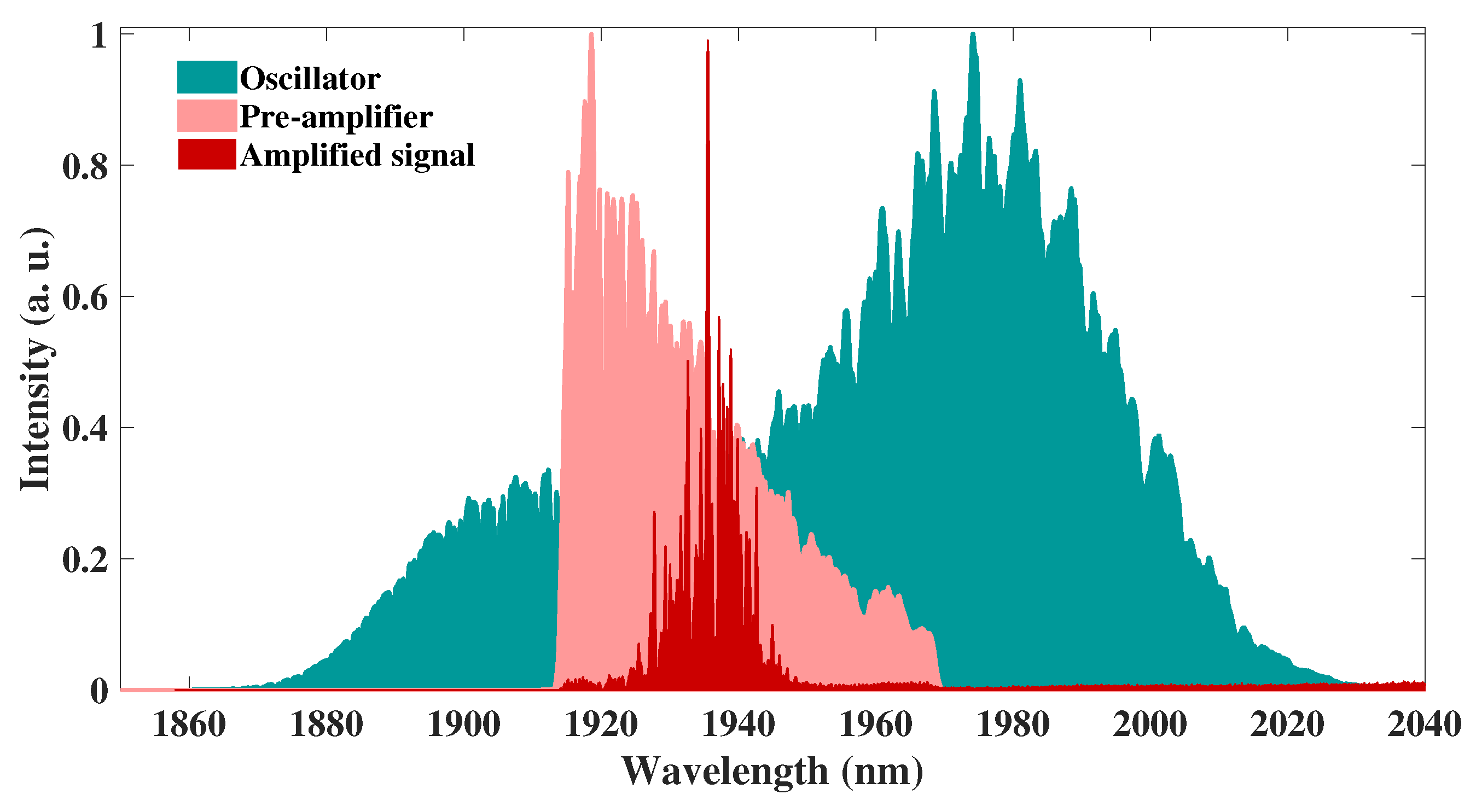

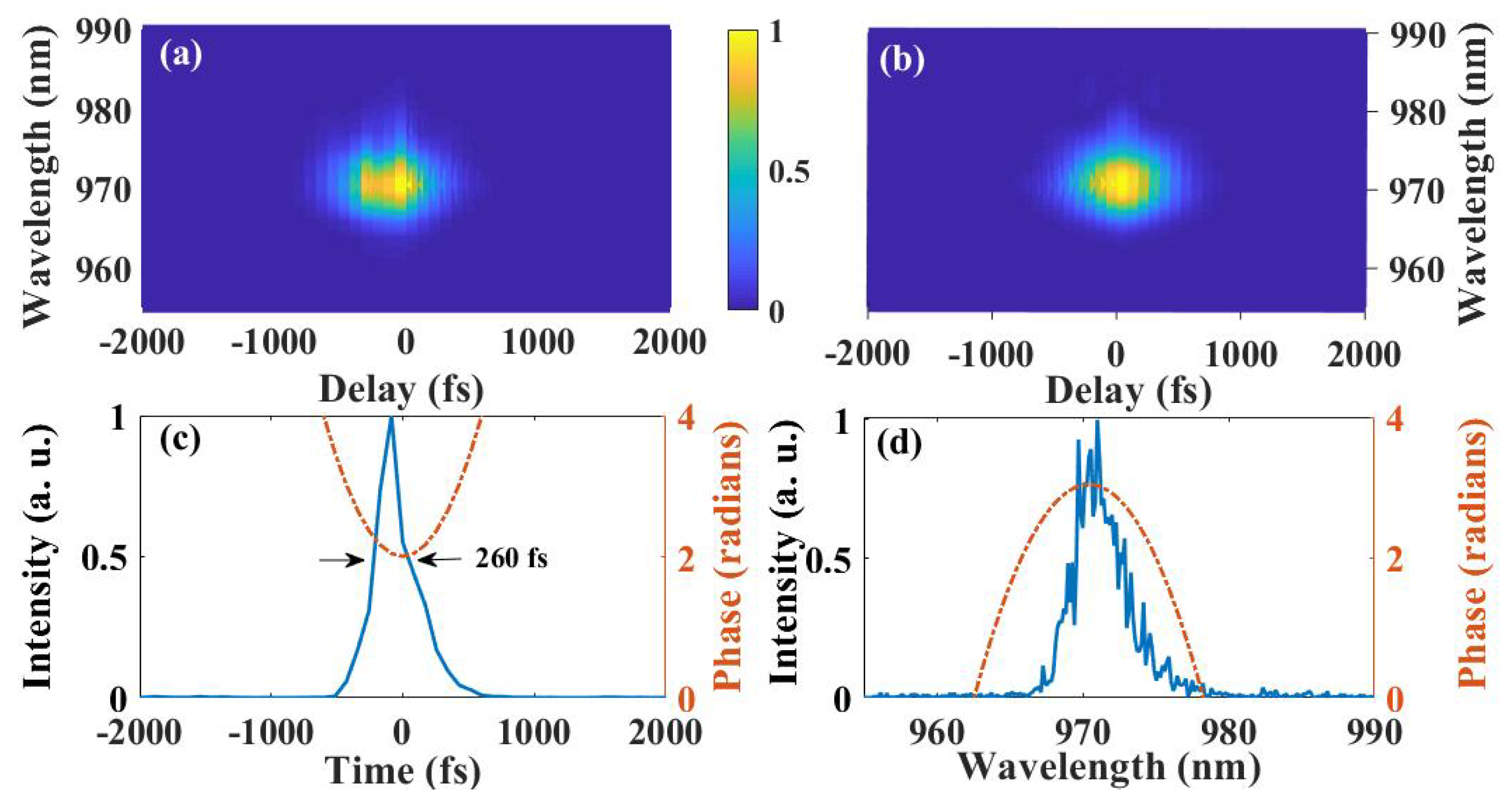
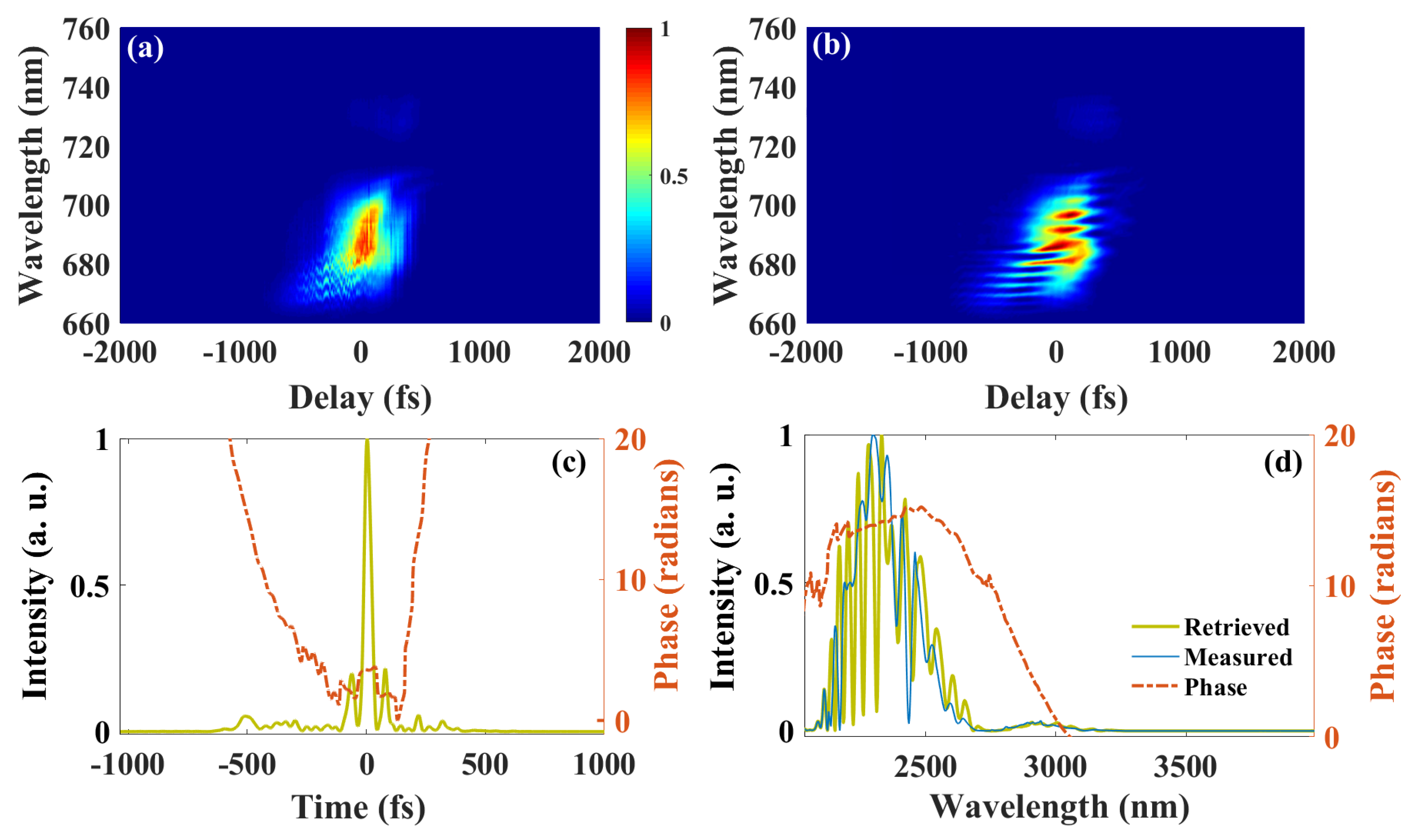

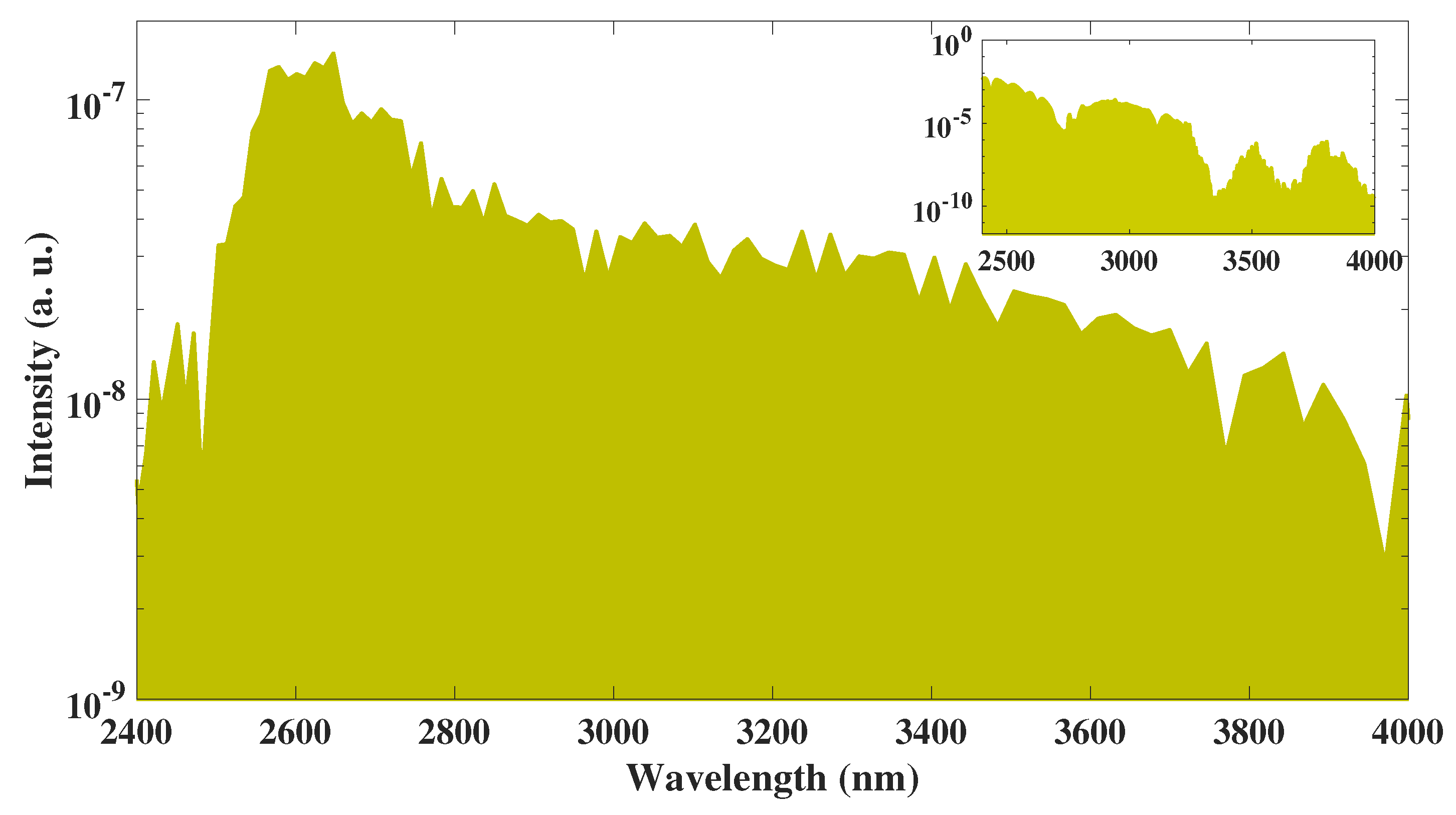
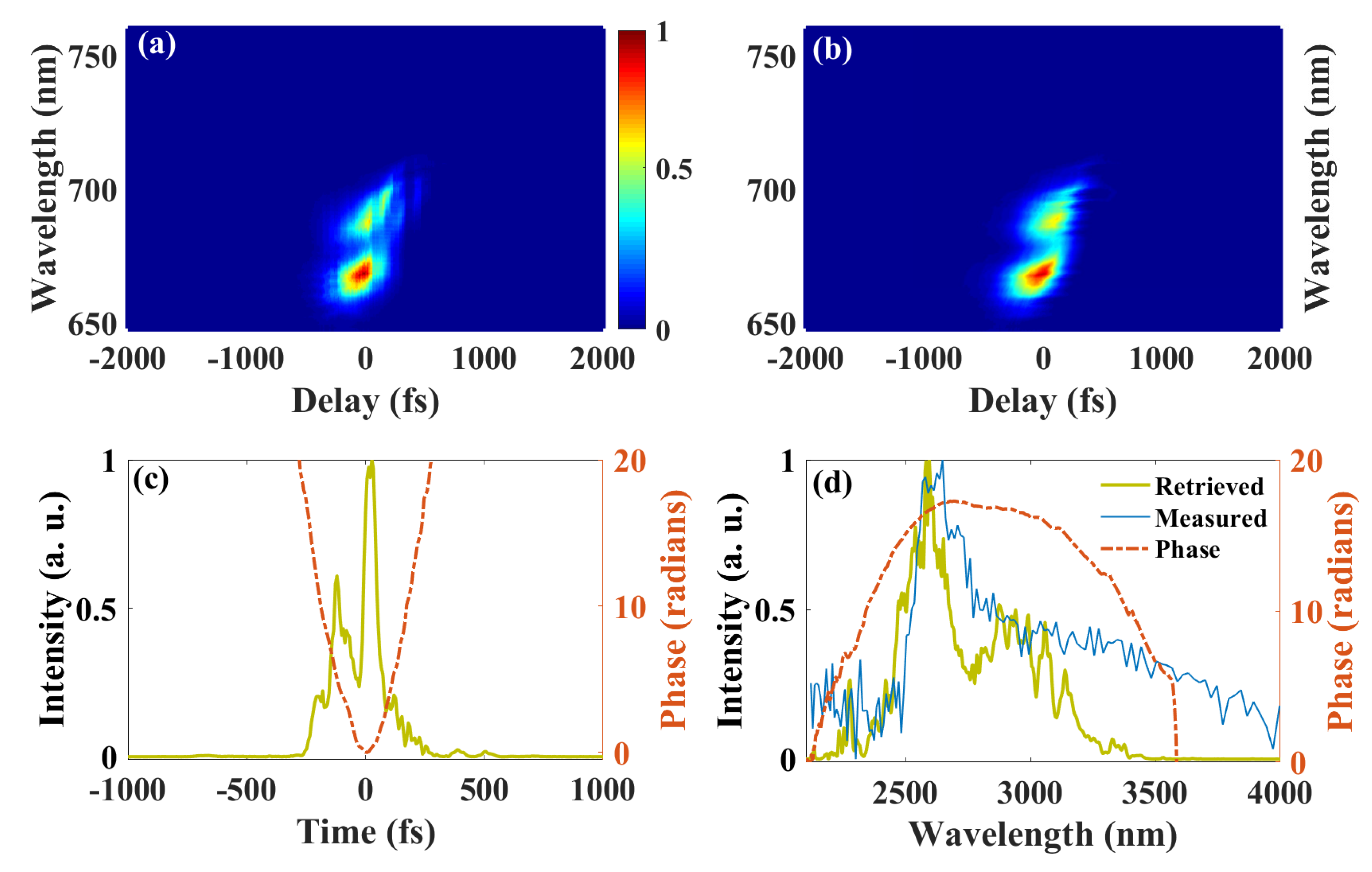
© 2019 by the authors. Licensee MDPI, Basel, Switzerland. This article is an open access article distributed under the terms and conditions of the Creative Commons Attribution (CC BY) license (http://creativecommons.org/licenses/by/4.0/).
Share and Cite
Rezvani, S.A.; Nomura, Y.; Fuji, T. Generation and Characterization of Mid-Infrared Supercontinuum in Bulk YAG Pumped by Femtosecond 1937 nm Pulses from a Regenerative Amplifier. Appl. Sci. 2019, 9, 3399. https://doi.org/10.3390/app9163399
Rezvani SA, Nomura Y, Fuji T. Generation and Characterization of Mid-Infrared Supercontinuum in Bulk YAG Pumped by Femtosecond 1937 nm Pulses from a Regenerative Amplifier. Applied Sciences. 2019; 9(16):3399. https://doi.org/10.3390/app9163399
Chicago/Turabian StyleRezvani, Seyed Ali, Yutaka Nomura, and Takao Fuji. 2019. "Generation and Characterization of Mid-Infrared Supercontinuum in Bulk YAG Pumped by Femtosecond 1937 nm Pulses from a Regenerative Amplifier" Applied Sciences 9, no. 16: 3399. https://doi.org/10.3390/app9163399




